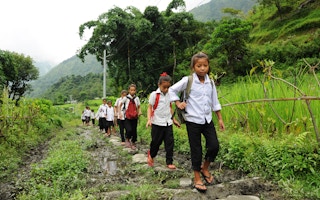In late September last year the new Sustainable Development goals (SDGs) were agreed in the United Nations General Assembly Hall in New York. From the media coverage, and the hundreds of world leaders gathered together at a single place and time to agree and adopt 17 SDGs and their 169 targets, the proverbial visitor from another planet would be excused for believing we have a genuinely global government.
To continue reading, subscribe to Eco‑Business.
There's something for everyone. We offer a range of subscription plans.
- Access our stories and receive our Insights Weekly newsletter with the free EB Member plan.
- Unlock unlimited access to our content and archive with EB Circle.
- Publish your content with EB Premium.
But we do not. There is no place or time when global decisions are taken and the law, regulation and other activities then change for the better to address our most pressing environmental and social challenges. Enlightened global governance is, perhaps sadly, an altruistic fantasy.
And yet it would be wrong to be cynical about the efforts of the United Nations. These new goals haven’t just been plucked from the air. They have been agreed following a global negotiation involving governments at all levels; experts in social economic and environmental policy; multinational businesses, and wider civil society.
They come after the experience of the Millennium Development Goals (MDGs): agreed in 2000 and tasked with achieving their targets by 2015. In order to assess the potential importance of the goals agreed in September, we must examine how successful the goals agreed 15 years ago have been.
Primarily focused on human development, the millennium goals have played a part in helping achieve real progress. From nearly half the developing world living in poverty at the end of the last century, the numbers of people now living in extreme poverty has been more than halved: falling from 1.9 billion in 1990 to 836 million in 2015. And with less people in poverty, the under-five mortality rate dropped from 90 to 43 deaths per 1,000 live births over the same period.
These results have not been achieved solely because of the MDGs. And the indicators on some of the goals have been disappointing. But the United Nations goals did create unprecedented focus strengthening and legitimising the work of aid agencies, governments and the private sector.
“
The job of establishing the SDGs and their targets is modest compared to the massive task of translating the “whats” into the “hows” of domestic policy and business activity.
No one involved in the hard work of drafting global social and environmental goals is naive enough to believe that all countries will meet all the targets. But if a country doesn’t, it is clear. The job of establishing the SDGs and their targets is modest compared to the massive task of translating the “whats” into the “hows” of domestic policy and business activity.
That the 17 goals and 169 targets are so many, and so broad, has brought criticism. After all, when there are that many dart boards on the wall you can surely throw blindfolded and hit at least one of the targets.
Fewer targets can achieve greater concentration and focus. And yet that the UN goals have now been broadened to include environmental goals, is a recognition that achieving human development will itself be constrained if the environment is despoiled in doing so.
As people become richer, if their increased consumption creates greater air and water pollution, then their health will suffer. And if emissions rise, further intensifying the global climate problem, then the effects could be both financially enormous, and socially and environmentally catastrophic.There can only be meaningful and enduring social gains with environmental progress.
Eradicating poverty by promoting sustainable, inclusive and equitable economic growth, reducing inequality, raising standards of living and pursuing the integrated and sustainable management of natural resources and ecosystems is no small project.
And it is particularly challenging in Southeast Asia where the OECD predicts economic growth will be 6.5 per cent a year over the coming five years. It will be the choices made by governments and businesses that will determine whether this growth helps achieve or thwarts progress towards achieving the SDGs.
In my work with Robertsbridge for clients in Southeast Asia over the past three years, I have seen these challenges first-hand. Where environmental objectives come into conflict with social development goals, despite those goals often being modest, all too often the loser is the environment.
Stand, as I have, in between desolate, silent, deforested land squelchy under foot due to the exposed peat, right next to the richness of a rainforest as yet untouched by the bulldozers, ask yourself who has the power to better protect and manage this landscape?
The answer is complex: a myriad of local and central government officials; international environmental agencies; concession holders; local landholders and large companies who supply to many of the brands known to any customer perusing the supermarket shelves.
In a globalised economy business must play a vital role in achieving human betterment and environmental stewardship. Take the example of Apple. Like many people, their products and services have become a vital part of my professional and personal life.
Lisa Jackson, Apple’s President for Environmental Initiatives, used to be head of the US Environment Protection Agency. In her government role she could influence and develop US environmental policy. At Apple she can now affect processes, policies and decisions that affect people wherever Apple products are sold.
Over 140 Apple Stores in the US - and all 21 Australian locations - are already running off 100 percent renewable energy. And the company has now purchased a forest in northern California and plans for sustainable forest management in China will ensure none of their packaging contributes to deforestation.
With media and digital communication making it ever easier for consumers to be informed about how and where the products they purchase are made, harvested and transported, consumers are becoming more aware of what lies behind a product and brand.
Digital technology is a potentially potent means whereby the social and environmental performance of countries and companies can be revealed and communicated. Smart phones can be a constant distraction ever shortening our attention spans, but a photograph and a tweet showing poor working conditions or a degraded forest can be shared with thousands of people in seconds.
There are already early applications that all consumers can have in the palm of their hands allowing them to scan a barcode and understand how a product’s supply chain performs.
Over the coming months and years all the governments that have signed up to achieving the SDGs will be developing policies and approaches to help achieve them. Some will succeed, and some may fail, but in trying to achieve them government will have to engage with the private sector.
And it will not only be the well-known brands and companies. These dynamics will come to affect the businesses that supply to them with the potential for a cascade effect through the global economy. To do nothing to achieve the goals will equal potentially damaging reputational risk. Yet to explore how each of the SDGs and targets could be furthered by decisions that a business can affect across their supply chain will clearly show that a company is serious about achieving more sustainable practice.
This is no fad, but part of a firm and growing trend. And it is a positive development that the recently launched SGX Sustainability Indices, composed of SGX-listed stocks, identify listed companies that are considered sustainability leaders with established and leading social and environmental performance.
No global business wants to be associated with human and environmental exploitation. The implementation of the SDGs will not now be led by the United Nations in New York or Geneva. It will come from a multitude of different decisions from governments, businesses, and individuals around the world.
The SDGs provide two vital things for any government or business wanting to do something meaningful on sustainability: a framework whereby they can decide what to do and review what they are already doing, and a rationale as to why they are doing it.
The process of implementing the goals can reveal new ways of doing business: creating high value with low emissions, quality products with better trained and rewarded workers and ways of communicating best practice which will make glossy sustainability reports look as if they are from the last century.
The social development goals are an important start. Achieving them will be hard. But if we are going to create a better world and a truly flourishing economy supporting people and the environment through this century, then the UN sustainable development goals provide a useful and potentially powerful driver for government and business to play their part.
Nick Rowley is the lead consultant working with Robertsbridge in Southeast Asia, Australia and New Zealand. He is also an Adjunct Professor at Sydney University, and was formerly advisor to Prime Minister Tony Blair on climate change and sustainability.











